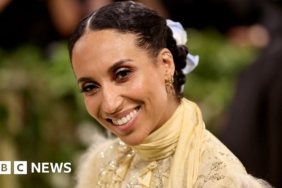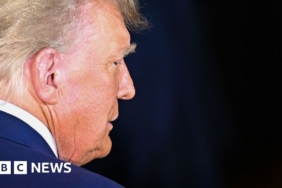Kaynak: www.npr.org

Pins are pictured at a counter during a cultural meeting at the Comanche Nation fairgrounds in Lawton, Okla., in September 2023.
Chandan Khanna/AFP via Getty Images
hide caption
toggle caption
Chandan Khanna/AFP via Getty Images
Voters in 25 states will have the opportunity to elect or reelect an Indigenous candidate to public office this year.
At least 170 Native American, Native Hawaiians, and Native Alaskans are on ballots this fall, an all-time high, according to a database collected by the group Advance Native Political Leadership. The group has been tracking Indigenous candidates dating back to 2016, from school boards all the way to the U.S. Congress.
Still, organizers and others say more work needs to be done to have representation that is proportional to national population sizes.
Advance Native Political Leadership has identified 347 current Native elected officials – less than 0.1% of some 519,000 elected offices nationwide. The organization estimates that number would have to be 17,000 to achieve parity based on the Native proportion of the U.S. population, which is 3%.

Little Buck Harjo carries ‘Nevada Votes Early’ signs at the reno-Sparks Indian Colony in Reno, Nev., on Oct. 15, 2024.
Frederic J. Brown/AFP via Getty Images
hide caption
toggle caption
Frederic J. Brown/AFP via Getty Images
“The most ground that we’ve gained has been at the state level,” said Elise Blasingame, an Osage Nation scholar in residence at the Advance Native Political Leadership, and an independent researcher at the University of Georgia focusing on the impact of Native representation on publicly elected offices.
Blasingame said that between 1993 and 2023, there has been a 300% increase, to about 80, in the number of state legislators alone who self-identify as Native American.
“Local efforts have tremendous power, not only in agenda-setting, but then showing other districts what can be done,” Blasingame said.
She predicts that one reason for the increase is a jump in Native American voter turnout.
“People see that either they have to engage, or they want to engage, with the U.S. political system to get policies in place that support tribal communities,” Blasingame said. As sovereign nations with a traumatic history with the federal U.S. government, many indigenous voters opt out of engaging, she said, adding that “It’s a dilemma that Native people have.”
Still, over the past few decades, legislative success in regards to gaming, lobbying, and other issues have proven how much representation matters.
Even just one candidate can create change
Native candidate representation varies greatly from state to state. In some states, like Oklahoma or Arizona, candidates are running at higher numbers. In other instances, candidates report being the only one.
State Sen. Mary Kunesh, a Democrat in the Minnesota state legislature and a descendant of the Standing Rock Nation, recalls being the third Native woman to join the governing body in 2017.
“For a while we had a nice little group of Native women in the Minnesota House, and with that kind of representation, we were able to bring forward a lot of the issues that our communities had been struggling with,” Kunesh said.
She recalls legislative success such as creating a state taskforce and permanent office of missing and murdered indigenous people. She now serves as co-chair of the National Caucus of Native American State Legislators, where she’s seem the impact of an increase in Native politicians nationwide.
In Mississippi, GOP Rep. Carolyn Crawford, Saginaw Chippewa, cosponsored successful legislation allowing Native residents to use tribal identification cards as a legal means of personal ID.

Oklahoma State House Rep. Ken Luttrell represents the 37th District in the state.
Oklahoma House of Representatives
hide caption
toggle caption
Oklahoma House of Representatives
In Oklahoma, where the state legislature has had a Native caucus since 2006, tribal members have been able to introduce and pass legislation to increase tribal sovereignty, economic development and government relations.
“We look for unifying causes that we can get behind and promote and educate the other legislators on issues that are important to the tribes and to Native American communities,” said Oklahoma GOP Rep. Ken Luttrell, who is running for the last time for his statehouse seat this November.
One of his proudest accomplishments is creating the statewide Casey Alert, which flags when a person over the age of 18 goes missing.
“These are ideas that are good for Indian country and for the state of Oklahoma, and also gives us the ability to work with tribes in our district,” he said.
Breaking the glass ceiling
Luttrell does draw leadership inspiration from others, such as Rep. Tom Cole (R-Okla.), a member of the Chickasaw Nation, who in 2022 became the longest serving Native American in the House of Representatives.
Democrats have also been inspired by members of their parties in higher roles, often pointing to Interior Secretary Deb Haaland, the first Native person in a Cabinet post, and heading a department that had been known for its abuse of tribes.
Shea Backus, a citizen of Cherokee Nation, is a Democratic incumbent running for Nevada’s State Assembly. She became the first Native American woman to serve in the Nevada state legislature in 2018 — a state with nearly 4%, or over 62,000, Indigenous people. She is still the only Native legislator on the state level.
Backus admires Haaland, as well as Minnesota Lt. Gov. Peggy Flannagan, a member of the White Earth Band of Ojibwe. Flannagan would become the first Indigenous female governor should Vice President Harris and her running mate Tim Walz win the presidential election.

State Representative Shea Backus, a member of the Nevada State Legislature, in Carson City, Nev., in 2019.
Melina Mara/The Washington Post via Getty Images
hide caption
toggle caption
Melina Mara/The Washington Post via Getty Images
She’s also hoping that others in Nevada will want to run for public office like her, too.
“I would way rather see one of our tribes here, have someone from the tribe or a descendant, who serves in our Nevada legislature, because all of the tribal communities are all different,” Backus said.
Still, the numbers are slowly increasing. According to the data gathered by Advance Native Political Leadership, at least 246 candidates, including 140 incumbents, ran for office in 25 states this year. Of those, 74 already won or lost their races, or withdrew or were disqualified, and are not on the November ballot.
Of those who identified with a political party, most were Democrats. Over half of the candidates running this year are female.
One of them is Trish Carter-Goodheart, a Nez Perce tribal member who is running for a second time for the Idaho state legislature. Her first attempt in 2022 had its challenges: she recalls not knowing how to set up a website, learning to manage TikTok and seeking out courses to overcome the fear of public speaking.
Carter-Goodheart, a Democrat, said she is the first from her tribe to run for the state legislature. In this second run, she made national headlines for being told to “go back where she came from” by another lawmaker.
“Not only is my identity politicized, the goal posts keep moving back for me,” Carter-Goodheart said. She said after that attack, some supporters urged her to be more vocal about her identity — including by wearing regalia from her tribe or publicizing photos of her family – both which made her uncomfortable.
“I really hope all these Native candidates running teaches the general public about the depth and wealth of Indian country,” she said.

Tennessee State Rep. Bryan Terry chairs the House Public Health Committee on in 2021, in Nashville, Tenn.
Mark Humphrey/AP
hide caption
toggle caption
Mark Humphrey/AP
In Tennessee, Rep. Bryan Terry, a member of the Choctaw Nation, is running for reelection – the only Native member in the state legislature enrolled in a tribe.
“It is not lost on me,” the Republican said, noting that former president and Tennessee Rep. Andrew Jackson signed the Indian Removal Act, which forcibly removed tribes in the south from their homelands. Now, Terry said he has given speeches at Jackson’s homestead and walks by two statues of him in the state capital regularly.
“Here we are 200 years later, I’m in a position that people at that time would not have wanted,” he said. “I get choked up when I think about that.”
Terry said some of his accomplishments include funding for the Native American Cultural Center in the state and speaking out against naming Jackson’s Bible as the state book. Ultimately, he hopes he can inspire the next generation to serve in public office, too, regardless of their background.
“I hope to be able to have people, young folks, look at that and think that, hey, I can do that, too,” Terry said.









Yorumlar kapalı.